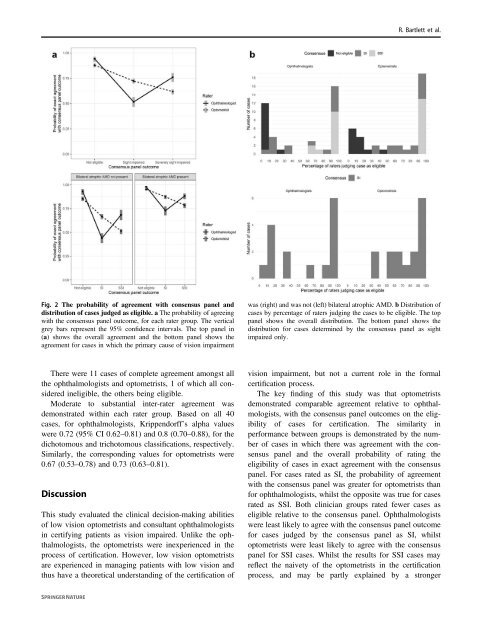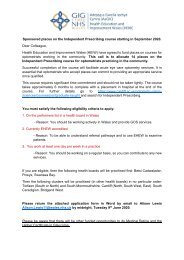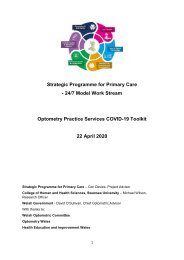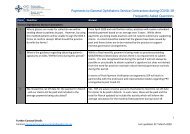Bartlett_et_al-2020-Eye
Create successful ePaper yourself
Turn your PDF publications into a flip-book with our unique Google optimized e-Paper software.
R. <strong>Bartl<strong>et</strong>t</strong> <strong>et</strong> <strong>al</strong>.<br />
Fig. 2 The probability of agreement with consensus panel and<br />
distribution of cases judged as eligible. a The probability of agreeing<br />
with the consensus panel outcome, for each rater group. The vertic<strong>al</strong><br />
grey bars represent the 95% confidence interv<strong>al</strong>s. The top panel in<br />
(a) shows the over<strong>al</strong>l agreement and the bottom panel shows the<br />
agreement for cases in which the primary cause of vision impairment<br />
was (right) and was not (left) bilater<strong>al</strong> atrophic AMD. b Distribution of<br />
cases by percentage of raters judging the cases to be eligible. The top<br />
panel shows the over<strong>al</strong>l distribution. The bottom panel shows the<br />
distribution for cases d<strong>et</strong>ermined by the consensus panel as sight<br />
impaired only.<br />
There were 11 cases of compl<strong>et</strong>e agreement amongst <strong>al</strong>l<br />
the ophth<strong>al</strong>mologists and optom<strong>et</strong>rists, 1 of which <strong>al</strong>l considered<br />
ineligible, the others being eligible.<br />
Moderate to substanti<strong>al</strong> inter-rater agreement was<br />
demonstrated within each rater group. Based on <strong>al</strong>l 40<br />
cases, for ophth<strong>al</strong>mologists, Krippendorff’s <strong>al</strong>pha v<strong>al</strong>ues<br />
were 0.72 (95% CI 0.62–0.81) and 0.8 (0.70–0.88), for the<br />
dichotomous and trichotomous classifications, respectively.<br />
Similarly, the corresponding v<strong>al</strong>ues for optom<strong>et</strong>rists were<br />
0.67 (0.53–0.78) and 0.73 (0.63–0.81).<br />
Discussion<br />
This study ev<strong>al</strong>uated the clinic<strong>al</strong> decision-making abilities<br />
of low vision optom<strong>et</strong>rists and consultant ophth<strong>al</strong>mologists<br />
in certifying patients as vision impaired. Unlike the ophth<strong>al</strong>mologists,<br />
the optom<strong>et</strong>rists were inexperienced in the<br />
process of certification. However, low vision optom<strong>et</strong>rists<br />
are experienced in managing patients with low vision and<br />
thus have a theor<strong>et</strong>ic<strong>al</strong> understanding of the certification of<br />
vision impairment, but not a current role in the form<strong>al</strong><br />
certification process.<br />
The key finding of this study was that optom<strong>et</strong>rists<br />
demonstrated comparable agreement relative to ophth<strong>al</strong>mologists,<br />
with the consensus panel outcomes on the eligibility<br />
of cases for certification. The similarity in<br />
performance b<strong>et</strong>ween groups is demonstrated by the number<br />
of cases in which there was agreement with the consensus<br />
panel and the over<strong>al</strong>l probability of rating the<br />
eligibility of cases in exact agreement with the consensus<br />
panel. For cases rated as SI, the probability of agreement<br />
with the consensus panel was greater for optom<strong>et</strong>rists than<br />
for ophth<strong>al</strong>mologists, whilst the opposite was true for cases<br />
rated as SSI. Both clinician groups rated fewer cases as<br />
eligible relative to the consensus panel. Ophth<strong>al</strong>mologists<br />
were least likely to agree with the consensus panel outcome<br />
for cases judged by the consensus panel as SI, whilst<br />
optom<strong>et</strong>rists were least likely to agree with the consensus<br />
panel for SSI cases. Whilst the results for SSI cases may<br />
reflect the naiv<strong>et</strong>y of the optom<strong>et</strong>rists in the certification<br />
process, and may be partly explained by a stronger

















